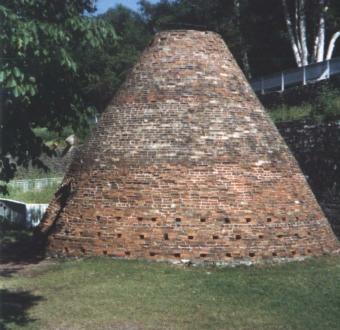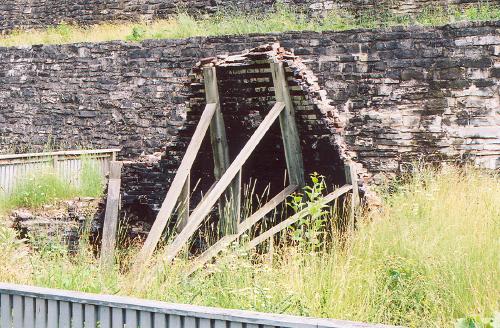 During the lifespan of Fayette Furnace, hundreds of these charcoal kilns dotted the local countryside in order to provide fuel for the furnaces. How they did this was simple. Cords of hardwood were dropped in through the top. The wood was then lit but not allowed to fully burn, just smoulder. This was done by regulating the air flow via the vents at the bottom. Experienced kiln operators called colliers relied on the smoke coming out of the kiln to let them know how the charcoal was progressing. When the charcoal was finished (it took about a week) it was removed by hand in bushel baskets through an opening at the bottom. They did it by hand to reduce breakage, smaller pieces of charcoal in the blast furnace restricted air flow.
During the lifespan of Fayette Furnace, hundreds of these charcoal kilns dotted the local countryside in order to provide fuel for the furnaces. How they did this was simple. Cords of hardwood were dropped in through the top. The wood was then lit but not allowed to fully burn, just smoulder. This was done by regulating the air flow via the vents at the bottom. Experienced kiln operators called colliers relied on the smoke coming out of the kiln to let them know how the charcoal was progressing. When the charcoal was finished (it took about a week) it was removed by hand in bushel baskets through an opening at the bottom. They did it by hand to reduce breakage, smaller pieces of charcoal in the blast furnace restricted air flow.
 One of the main reasons for Fayette's demise was the fact that charcoal fired furnaces were becoming outdated. Coke (coal treated by heat to remove impurities) fired furnaces out east were turning out iron for less money . At left is the only other standing remains of charcoal kilns at the complex. The rest are piles of brick rubble.
One of the main reasons for Fayette's demise was the fact that charcoal fired furnaces were becoming outdated. Coke (coal treated by heat to remove impurities) fired furnaces out east were turning out iron for less money . At left is the only other standing remains of charcoal kilns at the complex. The rest are piles of brick rubble.
Return to Fayette main page
 During the lifespan of Fayette Furnace, hundreds of these charcoal kilns dotted the local countryside in order to provide fuel for the furnaces. How they did this was simple. Cords of hardwood were dropped in through the top. The wood was then lit but not allowed to fully burn, just smoulder. This was done by regulating the air flow via the vents at the bottom. Experienced kiln operators called colliers relied on the smoke coming out of the kiln to let them know how the charcoal was progressing. When the charcoal was finished (it took about a week) it was removed by hand in bushel baskets through an opening at the bottom. They did it by hand to reduce breakage, smaller pieces of charcoal in the blast furnace restricted air flow.
During the lifespan of Fayette Furnace, hundreds of these charcoal kilns dotted the local countryside in order to provide fuel for the furnaces. How they did this was simple. Cords of hardwood were dropped in through the top. The wood was then lit but not allowed to fully burn, just smoulder. This was done by regulating the air flow via the vents at the bottom. Experienced kiln operators called colliers relied on the smoke coming out of the kiln to let them know how the charcoal was progressing. When the charcoal was finished (it took about a week) it was removed by hand in bushel baskets through an opening at the bottom. They did it by hand to reduce breakage, smaller pieces of charcoal in the blast furnace restricted air flow. One of the main reasons for Fayette's demise was the fact that charcoal fired furnaces were becoming outdated. Coke (coal treated by heat to remove impurities) fired furnaces out east were turning out iron for less money . At left is the only other standing remains of charcoal kilns at the complex. The rest are piles of brick rubble.
One of the main reasons for Fayette's demise was the fact that charcoal fired furnaces were becoming outdated. Coke (coal treated by heat to remove impurities) fired furnaces out east were turning out iron for less money . At left is the only other standing remains of charcoal kilns at the complex. The rest are piles of brick rubble.